The Wright (Brothers’) Stuff
Won Over By Reality
by Tim Bayer
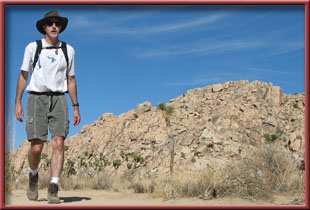 WEBSTER, NY—(Weekly Hubris)—7/12/10—I have commuted to and from work using my bicycle for many years, racking up thousands of miles of peddling. Through the repeated repair and maintenance of my two-wheeled transport, I’ve became a pretty proficient bicycle mechanic. Those into aviation are aware that the dream of powered flight was brought to reality by the Wright brothers . . . who owned a bicycle shop. That dream of flying, wheel-less, is obviously one shared by many, many cyclists, self included.
WEBSTER, NY—(Weekly Hubris)—7/12/10—I have commuted to and from work using my bicycle for many years, racking up thousands of miles of peddling. Through the repeated repair and maintenance of my two-wheeled transport, I’ve became a pretty proficient bicycle mechanic. Those into aviation are aware that the dream of powered flight was brought to reality by the Wright brothers . . . who owned a bicycle shop. That dream of flying, wheel-less, is obviously one shared by many, many cyclists, self included.
I, too, have always had the dream to one day own an aircraft and become a pilot. In the meantime, with a little imagination, riding a bicycle through the wind has served me as a sort of earthbound version of flight: I’ve been a big, fast bird with just really stumpy wings. In this aviation fantasy world, it’s been easy for me to draw astonishingly far-flung comparisons to flying, myself; emulating the Wright brothers; and, of course, ending up in-the-air. In my mind, it all gestated something like this: the Wright brothers were bicycle mechanics; I am a bicycle mechanic; the Wright brothers had a dream of flight; I have a dream of flight; the Wright brothers were amazingly ingenious; I am . . . a bicycle mechanic (etc., etc., ad nauseam).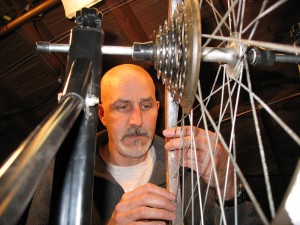
Though I longed for flight, I was faced with realities familiar to many earthbound but aspiring pilots: no airplane and a serious lack of funds. Without sufficient funds, I couldn’t just wander into my local aircraft dealership with my checkbook and emerge an airplane owner. (I derived some solace from the fact that the Wright brothers couldn’t wander into a local aircraft dealership, either.)
In the real world, what I did have in my corner were friends in the aviation community and my brother, Mark, who is an ultra-light pilot and mechanic. Timing, luck and generosity would combine to produce an aviation opportunity for me which all began during a simple phone conversation.
“The plane is free?” I asked.
“Yes. If you want it, Joe will give the plane to you,” my brother assured me. Mark then filled me in on the background of the aircraft.
Twelve years earlier, when Joe Hines purchased it, the used 1982 Rotec Rally 2B ultra-light plane was in flying condition. He disassembled the Rally, brought it home, and stored it for the winter. Unfortunately, right after the plane’s arrival, Joe’s dad fell ill. Joe took on the responsibility of dealing with utterly everything associated with the care of his dad, and the plane remained untouched.
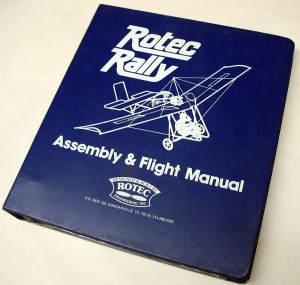
The key points in the tale of the Rally story are these: 1) The Rally, which had been stored for 12 years, would need work to get it back into flying condition; 2) The plane was available, for the asking, to a good home, provided it would be treasured, kept up and flown: Joe wouldn’t give it to me if it were going to end up on eBay; and 3) The original, complete Rotec Rally assembly manual was with the aircraft. That latter point was key!
The engine on the aircraft would need a bunch of work. My mechanical ability allowed me successfully to distinguish a bludgeoning implement (hammer) from a polygon torque lever (wrench), but my engine repair aptitude declined, at that point, sharply after the tool identification process.
On the other hand, my brother, Mark, at the opposite end of the engine skill spectrum, is an outstanding mechanic. The man can fix seemingly anything: automobiles, motorcycles, lawnmowers, aircraft, electrical appliances, portable generators, etc. I, however, possess excellent “supervisory skills,” and so I have personally witnessed Mark repair those and many other items at close hand. Mark is well aware of the limits of my mechanical abilities and that engine work will always be a stumbling point for me. If Mark were interested in working on the Rotec Rally motor refurbishing, I was confident I had the supervisory skills to watch him do it.
During our phone discussion, I paused with anxious hesitation before I began pitching woo to my brother. There was a complete, unspoken understanding that the “go or no go” decision for taking on this project would rely on Mark’s willingness to perform the engine work. All of it.
“What do you think about taking on this project?” I asked. My immediate flying future hanging in the balance, I awaited his response.
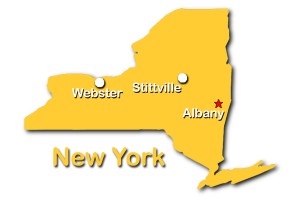
“Let’s do it,” was Mark’s reply. A day later, the Rotec Rally was transported from Stittville, New York to my garage in Webster.
The engine on the Rally is a Cuyuna 430, and the dern thing actually turned over (didn’t seize) but was a ways away from running condition. Mark and I removed the engine from the frame of the Rally and placed it on the work bench in the garage. The plan was to get the motor running smoothly while attached to a work bench. It would be much easier to work on the motor on the bench instead of six feet up atop the Rally frame.
Mark and I removed the heads and inspected the cylinders, and there was absolutely no carbon on either. The cylinders were smooth—no wear or defects—leading to the conclusion that the motor had probably been rebuilt before the plane was stored and may never have been started after the rebuild.
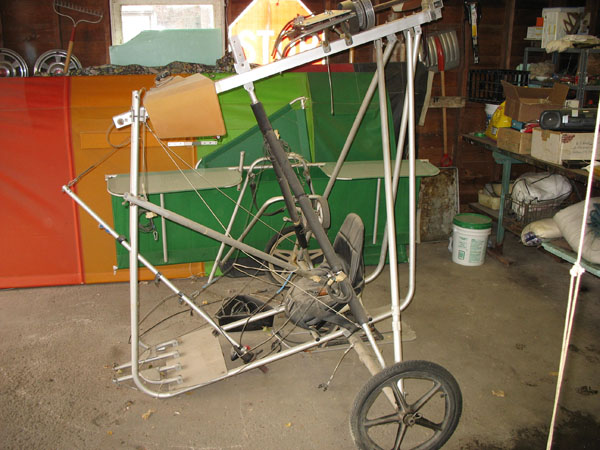
The rubber carburetor boot was dry-rotted from sitting for years, and the exhaust manifold gaskets were cracked. The spark plugs didn’t produce a spark when the engine was pulled over. Obtaining new engine parts would be our first challenge on my path to flight, and solving that problem would involve research and consulting with my aviation fiends.
I contacted Powered Parachute manufacturer, Nick Viscio, of Heldeberg Designs, and learned that Cuyuna was out of business but the engines and parts had been purchased by the engine company, 2si. I e-mailed 2si about part availability and was informed that 2si no longer built, serviced or supplied parts for Cuyuna engines. One step back for the Bayer brothers.
I searched the Web for a rebuilding kit for the 28mm Mikuni carburetor on the Cuyuna motor. None could be found. My research did uncover, however, a lead to Roger Zerkel of the company, ZDE. I called Roger and he said that rebuilding kits for a 28mm Mikuni carburetor were no longer manufactured. Another step back.
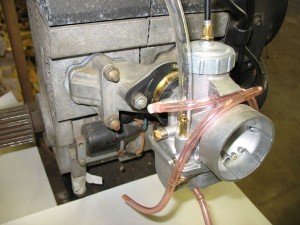
Roger informed me, as well, that the 32mm Mikuni carburetor was a suitable replacement and would fit on the Cuyuna 430. The 32mm carburetor was a commonly used carburetor these days and parts are widely available. According to Roger, the larger carburetor would likely pick up 2-4 horse power on the Cuyuna 430. Cool. Roger also said he had the parts I needed in stock. Double cool. I ordered the carburetor, air cleaner and rubber carburetor boot. I also ordered spark plugs, plug wires, condensers, new points, and exhaust manifold gaskets. Three steps forward.
The replacement parts arrived and Mark and I installed them into the motor. Actually, Mark installed the parts while I supervised. Mark fabricated some brackets out of steel and we bolted the motor to the work bench. We connected the new 32mm Mikuni carburetor to the Cuyuna motor. My management of the process was stellar, and I may have to give myself a hefty bonus and a pay raise.
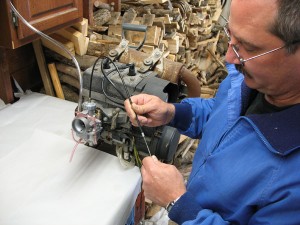
To enable throttle control, a short, improvised throttle cable was attached to the carburetor.
A temporary gas “tank” was also needed. A 16-oz. Mountain Dew bottle was modified to attach a fuel line to the mouth. The other end of the fuel line was attached to the carburetor. Two-stroke gas/oil mix fuel was put into the bottle. The 2-cycle fuel was mixed at 32-1 for my lawn mower. The Cuyuna feeds on a 40-1 mixture but, for this testing, the 32-1 mixture would do. A coat hanger was bent up to provide a bottle cradle and suspension hook, and the bottle was suspended from a cabinet above the motor.
This gave the impression of an I.V. bottle supplying fluids to a patient—rather appropriate in view of the ailing “critter” bolted to our work bench.
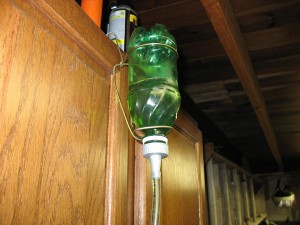
First problem of the day: no choke. Because I was new to buying parts for aircraft engines, I was unaware that choke mechanisms aren’t included in the purchase of a carburetor. So, my excitement at seeing the shiny new aluminum Mikuni carburetor fresh out of the box was dampened a bit when inspection revealed that the carburetor lacked a choke.
Second problem of the day: fuel leak. Mountain Dew’s improvised fuel line was too large for the nozzle on the carburetor. A quick run to the local hardware store for a smaller fuel line and we were once again in the garage wrenching on the motor. Even without a carburetor choke, we were ready for our attempt to get the motor running. Who needs a choke when you have starting fluid, which we did.
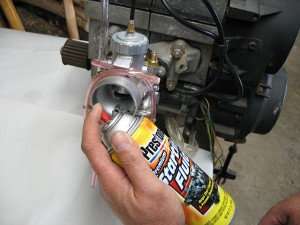
For those keeping score at home, it is worth noting that one of the most important characteristics of starting fluid is that it is highly flammable. Spray a liberal amount of starting fluid into a carburetor, and you get a wonderfully combustible mixture in the engine cylinders. So combustible that, in this instance, when the motor was pulled over, FLAMES jetted out of the barrel of the carburetor, accompanied by a loud bang.
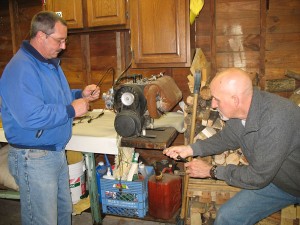
My excuse, from then on, for having little or no head hair. . . .
Accustomed to tuning motors and unaffected by the backfire, Mark did not jump. I did. Mark looked over at me, quietly chuckling. He then turned in the carburetor fuel mixture adjustment screw to the stop point and then backed it off two turns for a rough fuel mixture setting. The improvised throttle cable required Mark to use both hands for throttle operation. With one hand, he held the cable housing and with the other he moved the throttle cable. My job was to pull over the motor. A few tugs on the pull start rope, and the engine sputtered a bit and almost started. A quick shot of starting fluid, another tug, and the motor began running, but soon stalled.
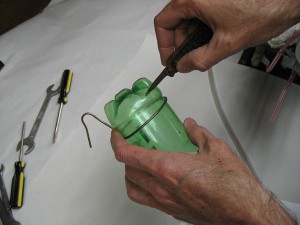 Third problem of the day: vacuum lock. The Mountain Dew bottle was sealed. As the fuel was drained by the running motor, a vacuum occurred in the bottle, inhibiting the fuel flow to the motor. We used a jack-knife to pierce a small hole in the plastic bottle to allow venting. (Real high-tech shop, the Bayers’ . . . .)
Third problem of the day: vacuum lock. The Mountain Dew bottle was sealed. As the fuel was drained by the running motor, a vacuum occurred in the bottle, inhibiting the fuel flow to the motor. We used a jack-knife to pierce a small hole in the plastic bottle to allow venting. (Real high-tech shop, the Bayers’ . . . .)
With the vented Mountain Dew “tank,” we again started the motor. Without a choke for the carburetor, the cold engine struggled a bit, bogged down, and then died. I know that a choke essentially inhibits the air flow down the barrel of the carburetor. I also know that if I placed the palm of my hand over the barrel of the carburetor, I could simulate the action of the choke mechanism. Since Mark was using both hands to adjust the throttle, there was a unique opportunity for me to be useful. I would also be adding “Manual Carburetor Choke Operator” to the experience section of my resume.
I pulled over the motor, which started. Each time it began to bog down, I choked the engine by covering the barrel of the carburetor with the palm of my hand. This maneuver was successful in keeping the engine from stalling. The two-person, three- handed engine controls worked fine, right up until a slight moment of miscommunication between the Bayers.
The motor had warmed up and was running well when Mark decreased the motor throttle. I thought the engine was stalling and choked the carburetor with my hand. To keep the motor running, Mark instinctively pulled the throttle cable, dumping fuel into the carburetor and—POW! Backfire!
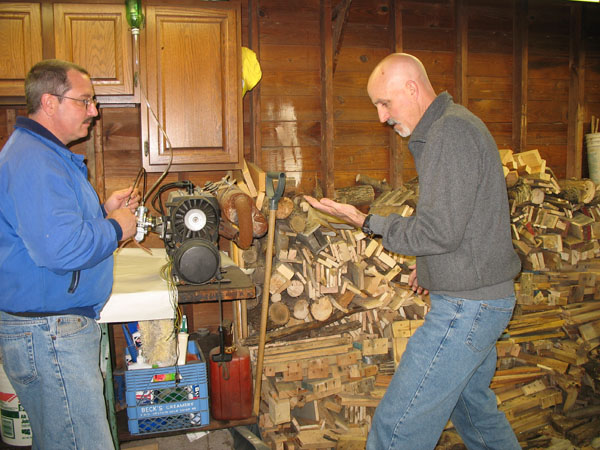
If there is a backfire when you are performing “Manual Carburetor Choke Operations,” not only do you get the loud bang and flash of flame, you also get the tactile input from a blast of hot air onto the palm of your hand. I was several feet away from the engine before the echo from the backfire faded. Immediately realizing by my reaction and facial expression that I was startled witless but uninjured, Mark found the split-second spectacle very entertaining.
After testing, we were satisfied that the new 32mm Mikuni carburetor and the Cuyuna engine functioned properly. The carburetor would need to be tuned, but the motor was operational.
My path to the sky was getting smoother by degrees: my shortage of start-up capital had been offset by the generosity of Joe Hines, who had spotted me an aircraft; and the engine repair wizardry of my brother, Mark,plus having the original Rotec Rally assembly manual moved me even closer to a taxi down an airstrip. The possibility of flight was morphing from a pipe-dream into an attainable goal.
Like the Wright brothers, I was still a bicycle mechanic, but a helluva lot farther down the runway in my pursuit of flight.
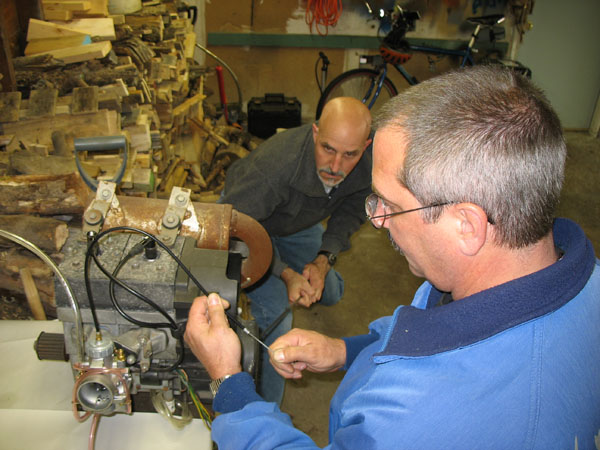


10 Comments
Eb Knowlton
Great article on the ultralight restration! Love to hear more. I prefer small fixed wing aircraft, but don’t fly anymore!
Eben
tbayer
Hi Eben,
Thank you. I have another aviation article on which I have been working that will be posted soon. Please check back in a week or two for that column.
Tim
Gheral Braga
Great Article,
I came across a similar situation, I happened to have an old cuyuna 430 out of a Rally 2 very much like yours.
I’m missing the cogbelt.
I wonder if you could possibly share with me some numbers for a replacement.
In other words, what kind of belt does it takes, pitch? length? width?
Best regards.
Tim Bayer
Hi Gheral,
Thanks. I could not afford the hanger fees for the plane so I sold it. What I would suggest is to contact ZDE Enterprises for parts. The information I found for ZDE on the web is listed below.
Tim
Zerkle Diversified Enterprises, LLC
Flat Rock, IL 62427-0247
Toll Free: (618) 584-3567
Email: zde@frtci.net
Web: http://www.zdenterprises.net/
merv
I too have a Ratec Rally 2b Mine is in storage ,, I am going too put back in the air,, I need assembly book, Wing covers , also cannot find clutch assembly I need help … Thanks
tbayer
I sold the Rotec Rally 2b a few years ago along with the manual. If you search on the web you can still find wing covers and similar parts. Good luck with your project.
azmat
My friend, I can’t find starting fluid in Saudi Arabia.
tbayer
If you don’t access to starting fluid, a little bit of gasoline may be a suitable substitute. Be careful!
Ted Tucker
How tall is the kingpost for rally. 2b ultralight ?
Tim Bayer
Hi Ted,
I no longer have the ultralight so I am not able to answer your question.
Regards,
Tim